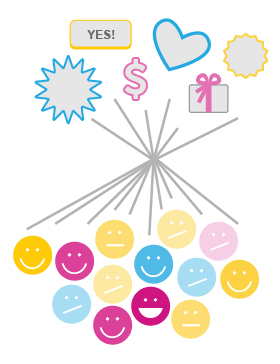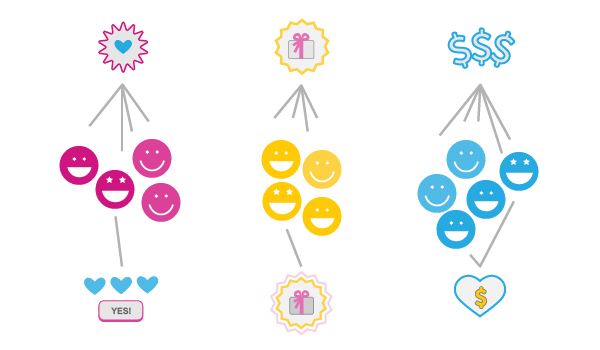
AI and the Retail Marketer’s Future
How AI transforms strategy and processes, driving the adoption of Positionless Marketing
Exclusive Forrester Report on AI in Marketing

Simply put, personalization means going from tends to hundreds of customer segments. To reap the benefits of having hundreds of segments, marketers must base these segments on the combination of historical, realtime, and predictive data. In other words, they must take into account their customers’ past, present, and future, so their communications are always relevant. To do this, CRM marketers need the most robust set of targeting capabilities that can significantly increase their customers’ value - at ease.
Let’s assume that your online business has a really sharp customer marketing and retention team. They are constantly dreaming up new offers and incentives to entice your customers to spend more, keep them happy and keep them coming back again and again. Let’s even say that the team is great at slicing and dicing your customer database to identify particular segments of customers worth targeting with particular offers. Overall, you are pleased with their performance as you watch your customer retention and lifetime values increase. What more can you expect?

Actually, you can expect a lot more! The fact is that even the smartest marketers are incapable of thinking in an unlimited number of dimensions. It’s simply too difficult to juggle the myriad variables involved in accurately measuring the effectiveness of every campaign, determining which campaigns are most effective for which customer personas, and identifying even smaller and more focused customer target groups to get even higher campaign response.
In other words, there is a high cost of generalization when it comes to customer marketing. Until the marketing team has discovered the ideal matches between every campaign and every customer persona, they are leaving money on the table.
The solution is to implement an approach that systematically replaces relatively crude campaign-customer matches with ever more fine-tuned and personalized marketing efforts. This is where the big money is!
Systematically Optimize Your Customer Marketing At Scale
Dear marketer, coming up with great campaign ideas will always be your purview. The next evolution in maximizing your marketing effectiveness is for you to focus on sending the most effective campaigns to each and every customer.
The optimization cycle you should be working towards looks like this:
To read more about this process, and see an example, see our blog post, Divide and Conquer for Killer Marketing Campaigns.
This highly effective approach to ever-increasing marketing personalization has proven to consistently and dramatically increase customer spend, customer retention and customer lifetime value.

You Can Only Scale Personalization With Next-Gen Tech
While straightforward in theory, the above process is one that does require some sophistication on the part of the marketer (or some good software to manage the process and perform all the required calculations). Here are some practical challenges that you will have to address to incorporate this process into your marketing:
But, this could all be easier...
Plug In Some Next-Gen Tech
If you’ve read this far, the thought might have crossed your mind that implementing this approach may be a little more than you can easily handle. Don’t give up just yet – technology is here to help! Optimove’s ability to create extremely homogenous and compact micro-segments results in an unparalleled degree of customer micro-segmentation accuracy. It combines realtime segmentation with predictive and historical data for hyper-personalized CRM.
Everything described above (besides coming up with the great campaign ideas!) is exactly what our Optimove retention automation platform does for customer marketers. This systematic approach to marketing optimization promotes dramatic ongoing improvements in campaign effectiveness, both by identifying those customers who best respond to existing campaigns and by isolating those customers to whom marketers need to develop more effective campaigns. Within months of starting to use Optimove to manage their customer marketing efforts, marketers typically reach the point that they are regularly and automatically sending highly targeted campaigns to hundreds of distinct, finely selected customer groups.
Exclusive Forrester Report on AI in Marketing
In this proprietary Forrester report, learn how global marketers use AI and Positionless Marketing to streamline workflows and increase relevance.


Pini co-founded Optimove in 2012 and has led the company, as its CEO, since its inception. With two decades of experience in analytics-driven customer marketing, business consulting and sales, he is the driving force behind Optimove. His passion for innovative and empowering technologies is what keeps Optimove ahead of the curve. He holds an MSc in Industrial Engineering and Management from Tel Aviv University.


